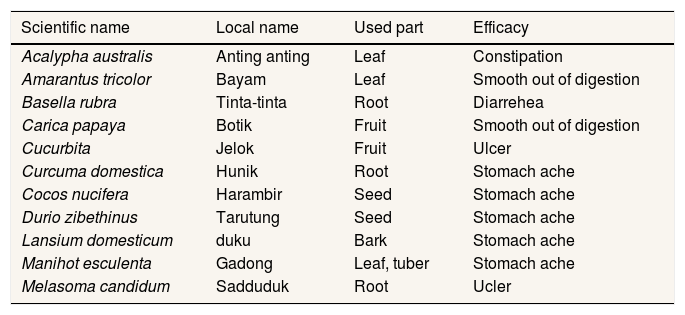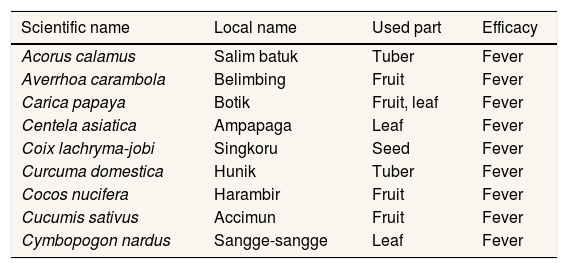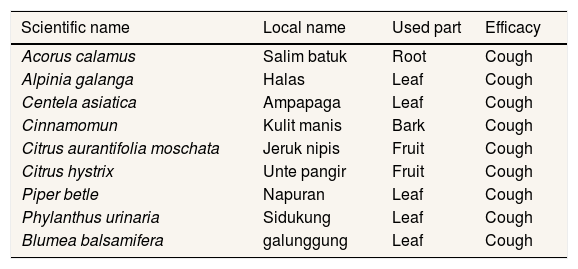
The 3rd International Nursing and Health Sciences Students and Health Care Professionals Conference (INHSP)
Más datosThis study aimed to describe the use of medicinal plants for the health of mothers and children and to describe the local knowledge in traditional medicine to cure diseases that are often experienced by mothers and children in Tipang village, Humbang Hasundutan Regency, North Sumatra Province.
MethodThis study used a qualitative method with an interactive model. The scientific approach used in this research is local wisdom.
ResultThe local knowledge of the Tipang community is based on local wisdom on the use of herbs in traditional medicine. Besides the local knowledge about the types of medicinal plants, they also know how to apply it to therapy, especially massage therapy. Specifically, they use this traditional medicine for the health of mothers and children, including the use of bangun-bangun leaves to increase milk production, pultak-pultak (Physalis angulata), Bulung ni untejau (guava leaves), hunik (Curcuma domestica), botik (Carica papaya), harambir (Cocos nucifera) used to treat colic, ginger are used to reduce fever in children, paet-paet leaves are used to heal wounds, and halas (Alpinia galanga), and Napuran (Betel leaf) are used to treat the itching.
ConclusionTraditional medicine is part of the cultural system of the people of Tipang Village which has enormous potential benefits in building public health, particularly maternal and child health.
Medicinal plants are all plants, whether they have been cultivated or not, which can be turned into medicinal plants, from what is visible to what is only visible under a microscope. Traditional medicine is part of the cultural system of society which has enormous potential benefits in the development of public health.1 The use of traditional medicine for self-care tends to increase. Internationally, traditional medicine using herbal medicine has been increasingly advanced. The first step that is very helpful in getting to know medicinal plants is from the knowledge of traditional people from generation to generation. Traditional ethnic groups in Indonesia have clear cultural characteristics and identities, so it is there may be differences in people's perceptions and conceptions of vegetable resources in their environment, including the use of plants as traditional medicines.2
Traditional medicine is a health effort in a way that is different from medical science, rooted in traditions originating from the tribe itself or outside the tribe. Cultural traditions including local medicine that are owned by a tribe or region tend to be a tradition passed down from generation to generation among the community.3
Traditional medicine is one of the alternative treatments that are trending in society. Usually done by using herbal plant ingredients, which are by following per under the dosage and dose of the type of disease suffered, so that they do not cause side effects. Traditional medicine is known by the community not only domestically but also abroad. According to research from the United States National Institutes of Health, one-third of Americans take alternative medicine besides seeing a doctor. Meanwhile, the US National Center for Health Statistics (NCHS) states that 18% of Americans consume herbal medicines. One area that was formerly known for its traditional medicine and utilizing herbal plants in Indonesia, including the Toba Batak ethnic community. Before the entry of European culture (Christianity) in the Toba Batak area. Treatment is carried out using traditional medicine.4
In the culture of the Batak community, traditional medicine which is often used in everyday life has become a community belief (local wisdom) that can cure diseases. Batak society is inseparable from traditional medicine which has been ingrained in their lives as a result of community culture. Even though the world of medicine is growing, it does not mean that traditional medicine by utilizing herbs as ingredients are receding. The Batak people have been able to identify plant species that are known and used for medicinal herbs. Parts of medicinal plants that can be used and utilized as traditional medicine, such as roots, stems, leaves, flowers, fruit, and others.5
Some of the Batak people who still use plants for traditional medicine are those who live in Tipang Village, North Sumatra. However, the knowledge about medicinal plants and how to use them by the Batak tribe in Tipang Village has not been well documented. Therefore, as a first step to support the development of traditional medicines in Tipang Village, it is necessary to research the use of medicinal plants by the Batak community in Tipang Village.
MethodThis research applied qualitative paradigm underlying the data collection coming from interview manuscripts, field notes, personal documents, memo notes, and other official documents. The scientific approach used in this research is the cultural approach. The research method used is qualitative is an interactive model. Interactive model of the qualitative standard used four interactive steps, namely data collection, data condensation, data display, and conclusion drawing/verification as follows (Table 1).5 The anthropolinguistic approach was applied in this study with the analytic parameters: interconnection, valuability, and sustainability. It was used in data analysis when applying three interactive analysis in data condensation, data display, and conclusion drawing or verification (Fig. 1).
Medicinal plants to treat indigestion.
| Scientific name | Local name | Used part | Efficacy |
|---|---|---|---|
| Acalypha australis | Anting anting | Leaf | Constipation |
| Amarantus tricolor | Bayam | Leaf | Smooth out of digestion |
| Basella rubra | Tinta-tinta | Root | Diarrehea |
| Carica papaya | Botik | Fruit | Smooth out of digestion |
| Cucurbita | Jelok | Fruit | Ulcer |
| Curcuma domestica | Hunik | Root | Stomach ache |
| Cocos nucifera | Harambir | Seed | Stomach ache |
| Durio zibethinus | Tarutung | Seed | Stomach ache |
| Lansium domesticum | duku | Bark | Stomach ache |
| Manihot esculenta | Gadong | Leaf, tuber | Stomach ache |
| Melasoma candidum | Sadduduk | Root | Ucler |
As a qualitative research, the informants were collected by purposive sampling. The researcher conducted the study in the natural setting with emic and inductive perspective. This research was conducted at Tipang Village, Baktiraja District, Humbang Hasundutan Regency, North Sumatera Province for six months in February–August 2020.
ResultUse of medicinal plants for mother and childThe results of this study are presented in several tables as follows.
DiscussionThe Toba Batak community knows medicinal plants to treat various diseases. Traditional medicine is used for mothers and children (Table 4) by utilizing plants around the home environment and those in the yard. The use of these plants is accompanied by local wisdom to formulate or process these plants into medicines that can heal or reduce pain.3,6 Some of the diseases that are often experienced by children below include: Diseases related to digestion (Table 1), fever (Table 2), wounds, respiratory tract such as coughs, and flu (Table 3). Diarrhea disease is a digestive disease that often affects children in Tipang Village. One type of medicinal plant used to treat gastrointestinal diseases is paet flower (Eupatorium perfoliatum) and guava (Psidium guajava) which are used to treat ulcers and diarrhea. The method of processing and using paet flowers to treat boils is that the leaves of the paet flowers are boiled until they boil after drinking, while in guava, young leaves or shoots are eaten without being processed.7,8
Medicinal plants to treat fever.
| Scientific name | Local name | Used part | Efficacy |
|---|---|---|---|
| Acorus calamus | Salim batuk | Tuber | Fever |
| Averrhoa carambola | Belimbing | Fruit | Fever |
| Carica papaya | Botik | Fruit, leaf | Fever |
| Centela asiatica | Ampapaga | Leaf | Fever |
| Coix lachryma-jobi | Singkoru | Seed | Fever |
| Curcuma domestica | Hunik | Tuber | Fever |
| Cocos nucifera | Harambir | Fruit | Fever |
| Cucumis sativus | Accimun | Fruit | Fever |
| Cymbopogon nardus | Sangge-sangge | Leaf | Fever |
Medicinal plants to treat colds and coughs.
| Scientific name | Local name | Used part | Efficacy |
|---|---|---|---|
| Acorus calamus | Salim batuk | Root | Cough |
| Alpinia galanga | Halas | Leaf | Cough |
| Centela asiatica | Ampapaga | Leaf | Cough |
| Cinnamomun | Kulit manis | Bark | Cough |
| Citrus aurantifolia moschata | Jeruk nipis | Fruit | Cough |
| Citrus hystrix | Unte pangir | Fruit | Cough |
| Piper betle | Napuran | Leaf | Cough |
| Phylanthus urinaria | Sidukung | Leaf | Cough |
| Blumea balsamifera | galunggung | Leaf | Cough |
Medicinal plant species used for the treatment of pregnancy and childbirth.
| Scientific name | Local name | Used part | Efficacy |
|---|---|---|---|
| Carica papaya | Botik | Fruit, leaf | Breastfeeding smoothly, postpartum |
| Kaemferia galanga | Hasior | Root | Breastfeeding smoothly, postpartum |
| Plectranthus amboinicus | Bangun-bangun | Leaf | Breastfeeding smoothly, postpartum |
| Sauropus androgynus | Nasi-nasi | Leaf | Breastfeeding smoothly, postpartum |
| Zingiber purpureum | Hunik | Root | Breastfeeding smoothly, postpartum |
One of the medicinal plants used to treat fever is Sibagure (Sidarhombifolia) Sibagure (Sidarhombifolia) which is a medicinal plant used by respondents in Tipang Village to treat fever and fever, namely the roots, which are processed and used, then boiled the roots. Drunk.9
One of the medicinal plants used to treat wounds is Bandotan (Ageratum conyzoides). The medicinal plant Bandotan (Ageratum conyzoides) grows wild in Tipang Village and often uses this plant for external wounds. The method of processing and use is that the leaves are squeezed after that the leaves are attached to the injured part.10,11
One of the medicinal plants used to treat the respiratory tract is Salim cough (Acorus calamus). Salim cough medicinal plant (Acorus calamus) grows wild in Tipang. How to use the rhizome in the sun and then eat it immediately. One of the medicinal plants used for the care of pregnancy and childbirth is shapes (Plectranthus amboinicus). The medicinal plants (Plectranthus amboinicus) are grown in cultivation in Tipang Village. The method of processing and use is kneading the leaves and then cooking them.12,13
ConclusionTraditional medicine is part of the cultural system of the people of Tipang Village which has enormous potential benefits in building public health, particularly maternal and child health. These medicinal plants are used to cure various diseases that attack mothers and children. Local knowledge on how to mix and use these plants is local wisdom which is very important to be preserved and preserved.
Conflicts of interestThe authors declare no conflict of interest.
Peer-review under responsibility of the scientific committee of the 3rd International Nursing, Health Science Students & Health Care Professionals Conference. Full-text and the content of it is under responsibility of authors of the article.



















